
Prediction of Vibrations & Cutting force of single point cutting tool in turning by using Artificial Neural Network
Habilitationsschrift, 2015
95 Seiten
Leseprobe
Inhaltsverzeichnis (Table of Contents)
- Nomenclature
- Introduction
- Introduction to Machine Vibration
- Neural Network
- Artificial Neural Network
- Mathematical model of Artificial Neural Network
- Objectives of the Present Work
- Methodology
- Organization of the Report
- Summary
- Literature Review
- Introduction
- Artificial Neural Network
- Cutting tool vibrations
- Cutting force
- Summary
- Analysis of vibrations & forces in turning
- Introduction
- Vibrations on single point cutting tool in cutting
- Types of vibrations
- Vibration measurement using FFT Analyzer
- Forces on single point cutting tool in cutting
- Summary
- Experimentations
- Introduction
- Cutting Material
- Cutting tool Material
- Carbides
- Adjustable Cutting Parameters in Turning as Input
- Cutting speed
- Feed
- Depth of cut
- Output parameters in Turning
- Tool vibrations
- Cutting Forces acting on single point cutting tool
- Instrumentations
- Lathe machine
Zielsetzung und Themenschwerpunkte (Objectives and Key Themes)
This dissertation aims to develop a model that simulates the vibrational effects of rotating machine parts on a single point cutting tool during the turning process. The study focuses on the relationship between machining parameters, such as spindle speed, feed, and depth of cut, and the resulting tool vibrations and cutting forces.
- Modeling of tool vibrations and cutting forces in turning
- Application of Artificial Neural Networks (ANN) to predict tool behavior
- Influence of machining parameters on tool vibration and cutting force
- Development of a predictive model for tool failure prevention
- Contribution to a deeper understanding of the turning process dynamics
Zusammenfassung der Kapitel (Chapter Summaries)
The dissertation begins with an introduction to machine vibration and neural networks, laying the foundation for the study's methodology. The literature review examines existing research on Artificial Neural Networks (ANN) and their applications in predicting cutting tool vibrations and forces. Chapter 3 delves into the analysis of vibrations and forces during turning, focusing on the types of vibrations and the measurement techniques used. Chapter 4 details the experimental setup, including the cutting materials, tool materials, adjustable parameters, and output parameters measured. The dissertation concludes with a summary of the findings and recommendations for future research.
Schlüsselwörter (Keywords)
This dissertation focuses on the prediction of vibration and cutting force in turning operations using Artificial Neural Networks. Key concepts include: vibration, cutting force, orthogonal cutting, Artificial Neural Network, machining parameters, tool failure prevention, turning process dynamics.
Details
- Titel
- Prediction of Vibrations & Cutting force of single point cutting tool in turning by using Artificial Neural Network
- Autor
- Matin Shaikh (Autor:in)
- Erscheinungsjahr
- 2015
- Seiten
- 95
- Katalognummer
- V315987
- ISBN (eBook)
- 9783668159778
- ISBN (Buch)
- 9783668159785
- Dateigröße
- 4070 KB
- Sprache
- Englisch
- Schlagworte
- Vibration Cutting tool Turning ANN Prediction Cutting force Orthogonal cutting
- Produktsicherheit
- GRIN Publishing GmbH
- Preis (Ebook)
- US$ 39,99
- Preis (Book)
- US$ 51,99
- Arbeit zitieren
- Matin Shaikh (Autor:in), 2015, Prediction of Vibrations & Cutting force of single point cutting tool in turning by using Artificial Neural Network, München, Page::Imprint:: GRINVerlagOHG, https://www.diplomarbeiten24.de/document/315987
- Autor werden
- Ihre Optionen
- Vertriebskanäle
- Premium Services
- Autorenprofil
- Textarten und Formate
- Services für Verlage, Hochschulen, Unternehmen

- © GRIN Publishing GmbH.
- Alle Inhalte urheberrechtlich geschützt. Kopieren und verbreiten untersagt.
- info@grin.com
- AGB
- Open Publishing
Der GRIN Verlag hat sich seit 1998 auf die Veröffentlichung akademischer eBooks und Bücher spezialisiert. Der GRIN Verlag steht damit als erstes Unternehmen für User Generated Quality Content. Die Verlagsseiten GRIN.com, Hausarbeiten.de und Diplomarbeiten24 bieten für Hochschullehrer, Absolventen und Studenten die ideale Plattform, wissenschaftliche Texte wie Hausarbeiten, Referate, Bachelorarbeiten, Masterarbeiten, Diplomarbeiten, Dissertationen und wissenschaftliche Aufsätze einem breiten Publikum zu präsentieren.
Kostenfreie Veröffentlichung: Hausarbeit, Bachelorarbeit, Diplomarbeit, Dissertation, Masterarbeit, Interpretation oder Referat jetzt veröffentlichen!
- GRIN Verlag GmbH
-
- Nymphenburger Str. 86
- 80636
- Munich, Deutschland
- +49 89-550559-0
- +49 89-550559-10
- info@grin.com
-









